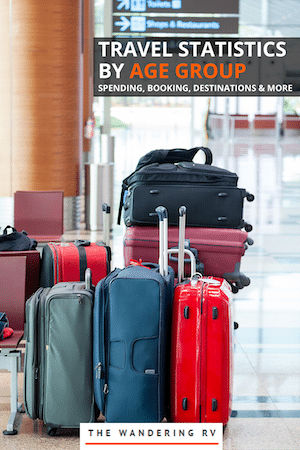With the average worker taking 17.2 days of vacation per year and spending $3,500 to $6,000 per trip, there‘s a lot of money in the travel industry. Millennials, in particular, travel 35 days a year and like to spend all their free time traveling.

Age is often a significant factor when it comes to making travel decisions.
Since each age group has its own unique set of needs and characteristics, each one is influenced and motivated in different ways.
This report seeks to share insights on each age group and contains over 70 travel statistics.
See the Table of Contents below for an overview!
Table of Contents
- Essential Travel Statistics by Age Group
- Which Age Group Spends the Most on Leisure Travel in the United States?
- What are the Most Popular Travel Destinations for Different Age Demographics?
- What Age Group Travels the Most & How do They Compare?
- What Inspires Baby Boomers, Gen Xers, Gen Z & Millennials to Travel?
- How do Different Generations Like to Travel?
- What Influences Travel Plans & Booking Habits?
Essential Travel Statistics by Age Group
- Most people who worked in America took a total of 17.2 days of vacation a year.
- 70% of Millennials preferred to stay in a hotel or motel during their travels.
- Those part of Gen Z use online travel agencies to plan and book their trips, and 43% of them stay for 29 days.
- The total amount spent by Baby Boomers on travel reached $157 billion last year.
- Millennials and those who belong to the Gen Z age group spend $60 a day on travel, averaging $3,500 spent while traveling.
- 35% of Millennials choose stay in luxury resorts when traveling.
- Social media factors into the vacation decisions of 90% of Gen Z travelers.
- Most Millennials take 35 vacation days a year and prefer to travel for all or most of the time they are not working.
- Gen X travels the least at 29 days, followed by Gen Z.
- 40% of Millennials and their friends are planning to travel in 2020.
- Most Gen Z travelers seek adventure during their trips.
- A quarter of people who belong to the Gen Z age group spent a quarter of their travel budget on flights.
- 83% of Millennials want all-inclusive vacation packages.
- More Millennials (77%) use the entirety of their vacations for travel as opposed to 62% of Baby Boomers.
Travel statistics by age group indicate that Millennial travelers seem to be the most diverse traveler group in terms of socioeconomic status and with whom they travel. Those who travel alone, with friends, or with partners tend to take more adventurous trip packages. However, those with children prefer family-friendly leisure activities and are increasingly likely to bring their children along with them on vacation.
Generation Z is still young and is thus limited in terms of its spending power. The younger generation seems to want to make the most out of their trips, spending the most time abroad.
Which Age Group Spends the Most on Leisure Travel in the United States?
- 25% of Gen Z travel budgets are spent on air travel.
- The vast majority of those who belong to Gen X look for the best deals before booking a vacation.
- 57% of boomers determine their trips based on their budgets, compared to 81% of those who belong to Gen Z.
- Tours and sightseeing make up 13% of Gen X vacation budgets.
- Boomers spend at least $1,865 per person on summer vacation travel.
- Boomers spent a total of $6,600 or more on trips in 2019.
- A one-week vacation costs 56% of Millennials between $500 – $1,000.
- Millennials spend $1,373 per person as an average on summer vacation travel.
- Gen X spends the most on summer vacations, at $2,628.
- The age group most likely to borrow money to travel are Millennials.
- 1 in 3 Millennials are wealthy enough to afford to pay $5,000 or more on a vacation.
- Baby boomers spend the most overall, able to afford over $6,000 on a single vacation.
Baby boomers lead the way when it comes to spending on vacation. This ability to afford more on their travels comes from their financial strength and stability. Most boomers over the age of 53 no longer have children living with them at home. Many are nearing or have already reached retirement age, which means they have more time and money to spend on vacations.
However, Generation X is the group most likely to spend more on vacations. The reason may be due to their responsibilities as parents of children who are still in school. More family members and a high-traffic travel season, like spring break or summer vacation, mean additional expenses.
Generation Z is the most restricted when it comes to financing travel. Air tickets alone often account for a quarter or more of their total budget.
What are the Most Popular Travel Destinations for Different Age Demographics?

Although both domestic and international travel is popular, domestic travel remains the most accessible to all age groups, and the most cost-effective.
- 51% of both boomers and Gen Xers will go on domestic trips compared to 42% of Millennials.
- Millennials averaged 19% in their tendency for international travel.
- People from the UK above the age of 65 prefer to visit Portugal, Italy, Spain, and France.
- 12% of people who belong to the Generation X age group traveled outside of their countries in 2019.
- 46% of Gen Xers, 51% of those aged 25 to 34, and 43% of baby boomers forecast traveling to both international and domestic destinations in the coming year.
- A small minority (7% Millennials, 6% of Boomers and 3% of Gen Xers) will only travel internationally in the upcoming year.
- Baby boomers plan and book their trips months in advance, at a rate of 56%.
- Gen X is less likely to travel abroad as opposed to other generations.
- Gen Z preferred to visit Rio de Janeiro, Tokyo, Buenos Aires, San Francisco, and Sydney.
Since they are older, those who belong to Gen X and the boomer age groups are more likely to be able to afford an international and domestic trip. Only a small number of people from all age groups plan to travel only to international destinations in 2020, the largest group being Millennials at 7%, followed by boomers at 6%.
The youngest generation in these statistics, Gen Z, prefers to go to cities more than other groups and likes to visit well-known and accessible cities. The most organized in terms of trip planning and also considered more responsible are boomers. The vast majority of baby boomers book months in advance for a trip and are more likely to seek luxury accommodations.
What Age Group Travels the Most & How do They Compare?
- Baby boomers who take both international and domestic vacations total 42%.
- Baby boomers who take both international and domestic vacations total 42%.
- Millennials take the longest vacations and average 35 total days a year.
- Generation Z takes the second-longest vacations, numbering 29 days.
- Baby boomers are most likely to take 27 days off for travel.
- Generation X has the fewest vacation days, at 26 total.
- Baby boomers will likely take 4-5 trips in 2020.
Baby boomers, by far, are the group most likely to travel and be able to afford it comfortably. They are expected to travel an average of 4-5 times a year, both to national and international destinations. However, they do not stay on vacation the longest. That number belongs to Millennials, who take the most extended vacations abroad and use up most, if not all, of their vacation days on trips.
As for Generation Z, they hold the spot for the second-longest vacation times but spend little compared to Gen Xers. Gen Xers travel less frequently than Gen Z, but they spend more money and usually go on different types of vacations due to their tendency to have family accompanying them.
What Inspires Baby Boomers, Gen Xers, Gen Z & Millennials to Travel?

There are different types of travelers in the United States. Each one has unique needs and plans their trips based on their age and lifestyle.
- Self-discovery was cited as the #1 reason for travel by 45% of Millennials.
- Baby boomers who travel to visit loved ones total 56%.
- Half of all trips taken by Millennials are to see their families.
- Millennials are 13% more interested in visiting historical and cultural sites as opposed to other age groups.
- Most Millennials (83%) prefer all-inclusive travel deals.
- Gen Z (40%) and Millennials (47%) like to take soothing vacations.
- People from the Gen Z age group mainly travel to visit family members at 56%.
Traveling is more than just sightseeing for the vast majority of people who expect their vacations to not only be enjoyable but memorable and bring them personal value. Being able to travel alone has several positive effects on people, such as broadening their world view. Furthermore, many people are motivated to find themselves while they rely entirely on themselves in a foreign country.
Millennials are most likely to seek options that give them the least amount of hassle and headaches as possible. Although they are not restricted to guided experiences, Millennials seem to want them to avoid any unforeseen issues along the way.
An increasing percentage of the younger generations, specifically Gen Z and Millennials, are now opting to take vacations solely for relaxation purposes.
How do Different Generations Like to Travel?
Depending on the distance, travelers have a wealth of options when it comes to choosing a mode of travel.
- 35% of Millennials prefer to have professional accommodation options like hotels.
- Most millennials (96%) have no issues with solo travel.
- Baby boomers are most likely to go on vacation cruises, followed by Millennials and Gen Xers.
- Millennials are the group most likely to travel to a major city at 38%.
- 43% of those who are part of Gen X use a car to travel domestically.
- Millennials do 70% of hotel bookings.
- Since most Gen Xers have children, 70% take family-oriented trips.
- Millennials are most likely to take an unconventional vacation.
- A quarter of boomers extend their business trip stays to enjoy leisure time.
- Weekend trips are most popular with Gen X (16%) followed by baby boomers (11%) and 12% of those aged 25-34 (Millennials).
- It is estimated that 40% of Millennials will book a trip with friends in 2020.
- 3 out of 10 boomers choose cruises to go on vacation trips.
- Millennial parents with children below the age of 5 travel at a rate of 62%.
As the industries that cater to different travel experiences increase in number, people now have different options that range from short, one-day or weekend vacations to package deals on cruises that take them to several different countries or islands.
Air travel remains the most convenient, safe, and accessible mode of travel. Air travel is especially popular when it comes to international destinations.
In terms of where they prefer to stay, most travelers still use hotels, motels, and hostels for accommodation. These accommodations differ based on the nature of the trip since travelers on cruises sleep in their cabins.
Millennials and Gen Z are the leading groups when it comes to city-based trip experiences. While older travelers are looking for more exotic experiences, the groups who grew up with technology were more likely to seek modern forms of travel and accommodations.
What Influences Travel Plans & Booking Habits?
- Only 1 in 10 Baby Boomers rely on social media to make travel-related decisions.
- Gen Z is the group most likely to be influenced by social media at 90%.
- 36% of Gen Z is influenced by social media when it comes to travel.
- More than half of those who belong to Gen X use online travel agents to book their travels (55%).
- Boomers are the group second most likely to be influenced by travel ads, at 66%.
- The group that is most influenced by advertising is Millennials, at 72%.
Based on the age group, the use of social media, the internet, and advertisements in general are touted as the most effective ways to influence travel plans. The group that is least influenced by advertisements are Gen Z, while those who are most influenced are Millennials.
Another noteworthy trend is the reliance on online reviews and social media to motivate travel decisions. Those who have been raised alongside technology are more likely to resort to online resources when planning their travels. Boomers were least likely to be influenced by social media posts or internet advertisements that cater to travelers, as they spend less time online than younger generations.
Travel agents and travel agencies still book trips, although the process has been digitized. These agencies often advertise for their own deals, and older age groups are more likely to book through them than to do so themselves.
Therefore, based on age, financial stability, and lifestyle, travel decisions are influenced by a multitude of factors. Boomers remain the biggest travel spenders, and women are quickly topping the lists for solo and group travel. When it comes to travel, each generation does it, and they all have their own ways of booking and enjoying their vacations.
Sources: Skift, Groupstoday, Accessdevelopment, Businessinsider, AARP, Avanti, GlobeTrender, Groupaccommodation, Expedia
Other statistic pages:




